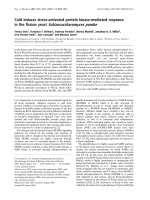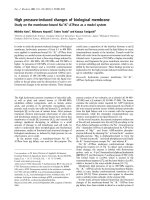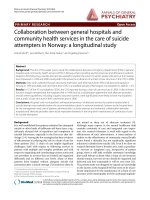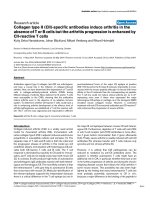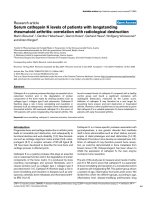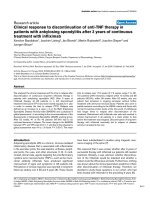Báo cáo y học: "Functional recovery after implantation of artificial nerve grafts in the rat- a systematic review" ppt
Bạn đang xem bản rút gọn của tài liệu. Xem và tải ngay bản đầy đủ của tài liệu tại đây (273.96 KB, 7 trang )
BioMed Central
Page 1 of 7
(page number not for citation purposes)
Journal of Brachial Plexus and
Peripheral Nerve Injury
Open Access
Review
Functional recovery after implantation of artificial nerve grafts in
the rat- a systematic review
Nektarios Sinis*
†1
, Armin Kraus
†1
, Nikolaos Tselis
3
, Max Haerle
2
,
Frank Werdin
1
and Hans-Eberhard Schaller
1
Address:
1
Clinic for Hand, Plastic, Reconstructive and Burn Surgery, BG Trauma Center, Eberhard-Karls University, Schnarrenbergstrasse 95, D-
72076 Tuebingen, Germany,
2
Dept of Hand and Plastic Surgery, Orthopaedic Hospital Markgroeningen, Kurt-Lindemann-Weg 10 D-71706
Markgroeningen, Germany and
3
Dept of Radiotherapy, Hospital of Offenbach, Starkenburgring 66, D-63069 Offenbach, Germany
Email: Nektarios Sinis* - ; Armin Kraus - ;
Nikolaos Tselis - ; Max Haerle - ; Frank Werdin - ; Hans-
Eberhard Schaller -
* Corresponding author †Equal contributors
Abstract
Purpose: The aim of this study was to compare functional data of different nerve-gap bridging
materials evaluated in rat experiments by means of a systematic review.
Materials and methods: A systematic review was conducted, searching MEDLINE, HTS and
CENTRAL to identify all trials evaluating functional recovery of artificial nerve conduits in the rat
model.
Results: There was a trend towards a favourable outcome of conduits coated with Schwann-cells
compared to the plain synthetics. Histomorphometry, electrophysiology and muscle-weight
correlated poorly with functional outcome.
Conclusion: Schwann-cell coated conduits showed promising results concerning functional
recovery. Further standardization in outcome reporting is encouraged.
Introduction
Peripheral nerve injury is common in trauma patients,
since, 4.5% of all soft-tissue injuries are accompanied by
defects of peripheral nerves [1]. The first attempts in
repairing peripheral nerve injuries were made in the 17
th
century [2]. In the 19
th
century, various options for the
surgical management of peripheral nerve injuries were
under debate, such as stretching the nerve, mobilizing the
nerve by joint flexion or bone shortening or bridging the
defect with various organic or synthetic materials [3]. In
the late 20
th
century, it became clear that tension across a
nerve repair site negatively affects regeneration which led
to preference of nerve grafting over manipulating proce-
dures [4]. Despite the well-known benefits of nerve graft-
ing, donor site morbidity must be taken into
consideration. To solve this problem, artificial nerve con-
duits are in evaluation, mainly in animal models. How-
ever, the most cost sparing animal model to start with
remains the rat. Herein, different nerves (i.e. median
nerve, sciatic nerve, facial nerve, etc.) were used in the past
to demonstrate the efficacy of numerous materials and
concepts (resorbable vs. non-resorbable, cellular vs. acel-
lular, etc.). This plenty of different experimental studies in
the rat were conducted with different techniques, materi-
Published: 25 October 2009
Journal of Brachial Plexus and Peripheral Nerve Injury 2009, 4:19 doi:10.1186/1749-7221-4-19
Received: 25 April 2009
Accepted: 25 October 2009
This article is available from: />© 2009 Sinis et al; licensee BioMed Central Ltd.
This is an Open Access article distributed under the terms of the Creative Commons Attribution License ( />),
which permits unrestricted use, distribution, and reproduction in any medium, provided the original work is properly cited.
Journal of Brachial Plexus and Peripheral Nerve Injury 2009, 4:19 />Page 2 of 7
(page number not for citation purposes)
als, and aims making a direct comparison of the data very
difficult. The aim of this study was to quantitatively com-
pare these different materials applied in the rat in order to
find the best concept for tubulization in the rat peripheral
nerve.
Materials and methods
Inclusion criteria
Since various parameters were analyzed in the different
studies, the overall aim was defined to compare func-
tional criteria among different concepts. Therefore, the
publications reviewed for this article all refer to the func-
tional efficacy of artificial nerve guidance tubes in the rat
model. This systematic review includes meta-analyses and
overview articles published between the years 2000 and
2008. Furthermore, controlled experimental studies were
included. Studies were rated as "controlled" if a compari-
son group existed. Studies were only included if they eval-
uated at least one artificial material (e.g. studies testing
vein grafts were excluded). Further, the material should be
applied in the upper or lower extremity of the rat (rat
facial nerve models were excluded since there are only of
limited clinical worth - see discussion). Finally, only those
studies were utilized where functional analysis was per-
formed (e.g. gait analysis or grasping tests).
Exclusion criteria
Uncontrolled studies as well as case reports, description of
the surgical methods, in vitro studies, studies performed
on animals other than the rat in order to warrant compa-
rability were not analyzed.
Search strategy
For literature search, the following databases were used:
Medline database
The Cochrane Central Register of Controlled Trials (CEN-
TRAL)
Health Technology Assessment Database (HTS)
Pub-med "related articles" function for included studies
The following key words were used: "nerve", "rat", "con-
duit", "tube", "regeneration", "artificial". Numerous com-
binations of these terms were individually applied and the
results compared using Medline's search history feature.
Articles were also identified by using the function "related
articles" in PubMed).
Management of references
The bibliographic details of all retrieved articles were
stored in an Endnote file. We removed duplicate records
resulting from the various database searches. The sources
of identified articles were recorded in a "user defined
field" of the Endnote file.
Study selection
Two members of the review team independently assessed
the titles and abstracts of all identified citations. English
or German language was a restriction. Decisions of the
two reviewers were recorded (order or reject) in the End-
note-file and then compared. Any disagreements were
considered by a third reviewer.
Two reviewers evaluated the full text of all potentially eli-
gible papers and made a decision whether to include or
exclude each study according to the inclusion and exclu-
sion criteria specified above. Final decisions on papers
were then recorded in the Endnote file. All studies that did
not fulfil all of the criteria were excluded and their biblio-
graphic details listed, with the reason for exclusion.
Data extraction strategy
Two reviewers independently recorded details about study
design, interventions, patients and outcome measures in a
predefined Windows Excel form. A small sample of stud-
ies with high likelihood for inclusion and exclusion
served to pretest the data forms. A third reviewer resolved
any discrepancies if the two reviewers disagreed. Biblio-
graphic details such as author, journal, year of publication
and language, were also registered. If any data were not
indicated in the text but shown in figures or graphs, data
were estimated therefrom.
Statistics
Thorough consultation with a statistician (Department of
Medical Biometry, University of Tuebingen) supplied evi-
dence that direct statistic comparison of the included
studies was not possible due to a variety in measured
parameters and timepoints too large to subsume them in
statistic tests. We therefore had to constrain our work to a
descriptive approach.
Results
Entering the above mentioned keywords yielded 384 ref-
erences in all scanned databases, From these, 62 were
selected for full-text assessment according to the applied
criteria. The selection strategies reduced the references to a
number of 12 publications that were compared in this
article. [see additional files 1 and 2].
Functional assessments
Ten of 12 studies used the sciatic functional index (SFI) as
a parameter for functional limb recovery, 1 study by
Piquillod used the peroneal score [5], the study of our
group performed on median nerve utilized a grasp test [6].
However, the SFI remains the most popular functional
test among experimental surgeons on that field. This test
Journal of Brachial Plexus and Peripheral Nerve Injury 2009, 4:19 />Page 3 of 7
(page number not for citation purposes)
is described in detail elsewhere [7]. Comparing the classic
silicone tube to other materials such as glutaraldehyde-
crosslinked gelatine or poly(l-lactic acid), PLLA showed
better results [8,9]. Chen MH could show significantly
better SFI (-38,1 vs -53,2) for glutaraldehyde-crosslinked
gelatine compared to empty silicone tubes 24 weeks after
implantation in their study published in 2006. Evans
reveal an SFI of 74,4 for empty silicone compared to 83,7
for PLLA in bridging a gap of 12 mm, measured after 16
weeks, this result being not significant.
In the results of Pilliquod [5] utilizing the peroneal score
[10], there was no significant difference between nerve
suture causing no gap, and a collagen tube with coating
layers of poly(lactide-co-glycolide) releasing either no or
various concentrations (6 ng/d, 10 ng/d or 15 ng/d) of
glial cell line-derived neurotrophic factor (GDNF) after 12
weeks across a distance of 3 mm. Peroneal score was 1152
for simple suture, 1161 for PLGA tube without GDNF. For
the factor-emitting tubes, peroneal score was 1176, 1233
and 1203 for 6 ng/d, 10 ng/d and 15 ng/d of GDNF emis-
sion. Furthermore, Schwann-cell alignment in the conduit
(either 2-dimensional or 3-dimensional) was shown to
have an influence on SFI regeneration. According to a
study of Kim published in 2007 [11], 3-dimensionally
aligned Schwann cells lead to a better SFI than 2-dimen-
sionally aligned Schwann cells (-60, Vs -87) over a gap of
10 mm measured after 12 weeks. Significance level was
not revealed due to the low case number (n = 6 per
group). According to a study by Mohammad conduits
manufactured of human amnion were not superior to
autologous nerve grafts across a distance of 10 mm con-
cering SFI, but almost equalled nerve grafts in this point
16 weeks after implantation (SFI -93,7 vs SFI -92,9) [12].
It surprises in these results, however, that also empty sili-
cone tubes showed SFI regeneration only little inferior to
amnion and nerve grafts (-91,0). In contrast the above-
mentioned study of Evans [9] shows inferior results of an
empty silicone tube compared to autologous nerve grafts
(SFI 74,4 vs 86,9), observed 16 weeks after implantation
over a gap of 12 mm. In another study by the group of
Evans from 2000 investigating late results after conduit
implantation over a 10 mm gap, an empty PLLA conduit
in comparison to an autologous nerve graft showed
slightly lower SFI values (105 vs 113 m, not significant)
32 weeks post implantation in the sciatic nerve of 31
Sprague-Dawley rats [13]. Rutkwoski investigated the
capabilities to bridge a 10 mm nerve defect of a poly(D, L-
lactic acid) (PDLLA) tube either with or without micropat-
terned lumen and with or without Schwann cell seeding
respectively [14]. They found significantly earlier onset of
functional recovery and higher peak recovery for the
experimental group where Schwann cell seeded tubes
with a micropatterned lumen were utilized.
In none of the included studies however, SFI reached with
an artificial conduit essentially surpassed SFI achieved
after nerve grafting or suture. Chen CJ et al. found a signif-
icantly improved SFI for a 15 mm nerve defect by utilizing
bone marrow stroma cell coated silicone tubes compared
to empty silicone tubes after 10 weeks [15]
Histomorphometric analysis
In the respective studies, a various number of histomor-
phometric parameters are reported such as total axon
number, number of myelinated fibres, total nerve area or
myelin thickness. High myelin thickness correlates well
with high sciatic functional index in the studies of Nie.
from 2007 [16], where autografts, empty PLGA-conduits
and PLGA-conduits with ectomesenchymal stem cells are
compared. After 16 weeks, the investigators found higher
SFI in the experimental groups with higher myelin thick-
ness (autograft and PLGA conduits containing stem cells
compared to empty PLGA tubes). Likewise, they showed
positive correlation of large nerve area and large fibre den-
sity to higher SFI values (autografts and stem-cell contain-
ing conduits possessed larger nerve areas and higher fibre
density than empty PLGA conduits). High axon number
was directly correlated with good functional recovery in
the work of Chen CJ et al [15]. According to results of our
group, high myelin thickness also lead to better results in
the grasp test than low myelin thickness 36 weeks after
surgery [6]. In contrast, our group achieved contrary
results when fibre density and the number of myelinated
fibres was compared to the functional index, as in the
experimental group with the lowest number of myeli-
nated fibres and the lowest fibre density per mm, func-
tional results were best [6]. The fact that functional
performance was better for experimental groups with
lower nerve fibre density is also seen in other studies. The
group of Tomita [17] could show higher fibre density in
all experimental groups undergoing surgery (whole nerve
graft, fascicular nerve graft and whole nerve graft and sili-
cone tube) compared to the control group undergoing no
surgery and serving as the gold standard for functional
performance. Also in the two above mentioned studies
from Evans form 2000 and 2002, functional outcome is
better for the experimental groups showing low fibre den-
sity than in the groups with high fibre density [9,13]. In
the study of Rutkowski from 2004 mentioned above [14],
there was no difference in nerve area and axon count for
the functionally superior group (micropatterned PDLLA
tube seeded with Schwann cells) in comparison to the
control groups (micropatterned PDLLA tube unseeded,
unpatterned PDLLA unseeded and unpatterend PDLLA
seeded).
Muscle weight
Several of the studies used weight analysis of a muscle
innervated by the operated nerve as a parameter for regen-
Journal of Brachial Plexus and Peripheral Nerve Injury 2009, 4:19 />Page 4 of 7
(page number not for citation purposes)
eration, such as the studies of Tomita, our group and
Evans [6,9,13,17]. Results however are mostly contradic-
tory.
In their study of 2002, the group of Evans found higher
SFI values in the experimental group with higher weight of
the gastrocnemius muscle [13], as well as the group arond
Chen CJ et al. comparing BMSCs coated silicone tubes to
empty silicone tubes [15]. Our group could only partially
confirm these results [6]. Later than 32 weeks after sur-
gery, functional performance was almost equal in the con-
trol group, in the autograft group and in the Schwann cell
seeded tube group. Muscle weight in the experimental
groups however was only 71.8% and 67.1% of that of the
control group. On the other hand, it was not astonishing
that the group showing no functional regeneration
(empty TMC/CL conduit) had the lowest muscle weights
measured (14% of the control group weight). Remarka-
bly, in the results of Evans from 2002, the experimental
group showing the best functional outcome (PLLA con-
duit filled with Schwann cells in a concentration of 1 mil-
lion cells per ml) had the second lowest muscle weight.
Electrophysiology
For electrophysiological tests, the respective studies uti-
lized either compound muscle action potential (CMAP)
or nerve conduction velocity. Tomita [17] found highest
CMAP for their control group undergoing no surgery.
They additionally found almost equal CMAP (68,1% and
73,2%) of the sciatic nerve 12 weeks after surgery in the
functionally equal study groups (fascicular nerve graft,
nerve graft and silicone tube, SFI -50 in both cases). Chen
MH et al. [8], comparing glutaraldehyde crosslinking gel-
atin conduits with silicone tubes, found higher CMAP
(0,80 mV) in the glutaraldehyde crosslinking gelatin con-
duits group which showed higher SFI (-38,1), whereas
they found lower CMAP (0,46 mV) in the silicone tube
group which showed lower SFI (-53,2) after 24 weeks.
Chen CJ et al. found higher CMAP in their experimental
group of BMSC coated silicone tubes than in their control
group of empty silicone tubes as well after 10 weeks. In
the study of our group [6], nerve conduction velocity was
measured in the control group, autograft group and TMC/
CL with Schwann cell tube group after 36 weeks. In all 3
groups nerve conduction velocity was equal (35 m/s),
which was in accordance to equal results in the functional
grasp test.
Discussion
With peripheral nerve injury being a common and serious
problem [2] there is a demand for surgical repair. Due to
the presence of donor site morbidity after harvesting of
nerves and the results that remain still far from satisfactory
after nerve grafting operations the hope of improving the
results by using artificial nerve conduits, lead to an inten-
sive research on that field [18-21]. Most of these studies
are performed in the rat, although we know about this
species to have excellent regeneration capabilities after
peripheral nerve injury [7]. However, the rat is still an
attractive animal model since the costs of these animals
are low and the rats are easy to handle. Therefore, we lim-
ited our literature search to this kind of studies. Further-
more, functional recovery appeared to be the
fundamental outcome parameter to us, therefore we
included only studies which quoted any of such tests. Rat
models of facial nerve tubulization were not included
because this reconstructive modality is of minor impor-
tance in trauma surgery of peripheral nerves which mostly
includes the upper extremity.
During the 20
th
century, a variety of non-biological mate-
rials such as cellulose esters, gelatine tubes, rubber and
plastics were under experimental evaluation [22]. Particu-
larly, Dahlin and Lundborg [23] showed that in human
short nerve defects can successfully be treated with sili-
cone tubes, with best results in large proximal nerves such
as the median and ulnar nerve [24]. In addition to non-
absorbable tubes, bioabsorbable tubes were tested experi-
mentally and also under clinical conditions [25-29]. As a
further development, tissue engineered tubes enriched
with elements such as specific cells or neurotrophic factors
were presented. Especially Schwann-cell coated non-bio-
logical conduits showed promising results, as shown in
the studies of Evans, our own results, the group of Rutk-
woski and in the work of Gravvanis [6,9,14,30,31]. Neu-
rotrophic factors used in bioengineered tubes were nerve
growth factor (NGF) [32], brain derived neurotrophic fac-
tor (BDNF) [33] or glial derived nerve growth factor
(GDNF) [5,34]. In the studies reviewed for this article,
there was a tendency towards better regeneration with cel-
lular filled conduits compared to plain acellular tubes.
Judging the comparability of the utilized materials was a
challenge in this review, since the studies included were
characterized by a large variety of measurement time-
points and outcome parameters quoted. According to sta-
tistical consultation, this fact made any statistical
comparison of the various studies unfeasible. We encour-
age any efforts to standardize outcome measurement in
the field of nerve tubulization to alleviate further reviews.
Yannas and Hill suggested a method for comparing regen-
erative capabilities of various tubulisation materials with
different gap lengths being chosen in different animal
models [35]. They used normalized length of bridged
nerve gaps in various species and determined the point of
50% successful myelinisation of the fitted fibers for vari-
ous materials. The authors found poly(lactic acid), a
copolymer of lactic acid and ε-caprolactone and a natural
polymer of type I collagen to induce a significantly better
axon outgrowth than ethylene-vinyl acetate copolymer
Journal of Brachial Plexus and Peripheral Nerve Injury 2009, 4:19 />Page 5 of 7
(page number not for citation purposes)
tubes. Furthermore, they found fibroblast growth factor
(FGF) to enhance myelinisation, but nerve growth factor
(NGF) did not, nor did addition of extracellular matrix
molecules such as laminin oder fibronectin. Concerning
non-cell-coated materials, the group of Waitayawinyu et
al. [36] found a type I collagen tube to produce superior
results compared to polyglycolic acid tubes (PGA) con-
cerning muscle contraction forces, axon counts and
weight of the innervated muscle. Interestingly, the group
of Clavijo-Alavrez et al. [37] found not difference neither
in SFI, gastrocnemius weight nor myelinated nerve area
when they compared polycaprolactone nerve guides,
polycaprolactone/collagenous beads composite guides
and polyglycolic acid guides in elder (11 months old)
Sprague-Dawley rats. Obviously, sharply decreased regen-
erative potential of peripheral nerves cannot be enhanced
by any artificial material.
Muscle weight measured as a possible outcome parameter
also correlated only partially with functional indices, indi-
cating that muscle hypertrophy is not a suitable character-
istic of muscle strength or function, regarding the results
of our group [6] or those of the group of Evans form 2002
[9]. It would be worthwhile to find a histomorphometric
or electrophysiological parameter that better correlate
with functional indices to facilitate transmission of in
vitro data to in vivo experiments. However, it was interest-
ing to observe that all histomorphometric or electrophys-
iologic measurements correlated only poorly with
functional outcome in the studies that were reviewed for
this work. With respect to any future clinical implementa-
tion, focus should be fixed on functional rather than tech-
nical parameters.
Regarding functional outcome, motor and sensory func-
tion tests can be distinguished as cited in the review by
Vlegeert-Lankamp [38]. Concerning sensory function
tests, animal reflexes after electrical stimulation of the
hindlimb have been measured, the operated nerve has
been pinched by a pair of forceps distal or proximal to the
graft location and muscle contraction or leg retraction was
measured, or the footpad was pinched and the withdrawal
response was measured. As sensory answer is another
parameter indicating whether a nerve has regenerated
through an artificial conduit, we recommend to take it
into account assessing the degree of recovery, even if there
is the well-known preference of motor over sensory reha-
bilitation. For measuring muscle tetanic force, the muscle
innervated by the sciatic nerve is cut, the tendon is fixed to
a force transducer and the nerve is stimulated measuring
the maximal force. Despite valuable information about
muscle force, the applicability of the test is limited to a
single experiment, making observations over a time
course unfeasible. Walking track analysis is a frequently
used method to evaluated peripheral nerve regeneration
as it provides information about both nerve motor and
sensory function and muscle force. Among various walk-
ing track tests, the SFI is still in widespread use, as it is in
the articles matching our inclusion criteria, although it
can be regarded as outdated in some aspects. The SFI is
calculated by a formula using printlength, hindpaw toe
spread (distance from first to fifth toe) and intermediate
toe spread (second to fourth toe). As contractures of the
operated hindlimb may occur over the time, the index is
susceptible for errors in long-term measurements. More
advanced methods of motion analysis such as those
described by Bozkurt. [39] or by Meek [40] utilizing video
analysis and taking both dynamic and static gait parame-
ters into account are promising. As already proposed by
Geuna [41], we recommend to standardize a combination
of advanced motor and sensory tests to make future
results from research in the field of peripheral nerve regen-
eration more comparable. Further studies will have to
show the best motor and sensory functional tests together
with their ideal combination.
Conclusion
Among the artificial nerve conduits analysed for this
review, especially those coated with Schwann-cells
showed promising results concerning functional recovery.
Functional recovery only partially correlated with histo-
morphometric parameters. Due to various different out-
come parameters in common use, comparability of the
studies is very limited. We encourage any standardization
in this field of research utilizing both advanced motor and
sensory functional tests to facilitate further meta-analyses.
Abbreviations
SFI: sciatic functional index; PLLA: poly(l-lactic acid);
PLGA: poly(lactide-coglycolide); TMC/CL: trimethylene-
carbonate-co-epsilon-caprolactone; PDLLA: poly(D, L-
lactide); CMAP: compound motor action potential.
Competing interests
The authors declare that they have no competing interests.
Authors' information
NS is a senior surgeon in plastic and reconstructive sur-
gery. His scientific work has mainly been concerned with
bioartificial nerve conduits in the rat model.
Authors' contributions
NS is responsible for the study design of this review and
the writing of the manuscript. AK did the literature search
and co-writing of the manuscript. NT and MH worked on
reviewed the existing literature and prepared them for
inclusion or rejected them. FW worked on data processing
and tabulation. HS edited the text of the manuscript and
consulted in study design. All authors read and approved
the final manuscript.
Journal of Brachial Plexus and Peripheral Nerve Injury 2009, 4:19 />Page 6 of 7
(page number not for citation purposes)
Additional material
Acknowledgements
We would like to thank Klaus Dietz, Department of Medical Biometry, Uni-
versity of Tuebingen, for his consult. No source of funding was utilized for
this review.
References
1. Dornseifer U, Matiasek K, Fichter MA, Rupp A, Henke J, Weidner N,
Kovacs L, Schmahl W, Biemer E, Ninkovic M, Papadopulos NA: Sur-
gical therapy of peripheral nerve lesions: current status and
new perspectives. Zentralbl Neurochir 2007, 68:101-110.
2. Belkas JS, Shoichet MS, Midha R: Peripheral nerve regeneration
through guidance tubes. Neurol Res 2004, 26:151-160.
3. Sanders FK, Young JZ: The degeneration and re-innervation of
grafted nerves. J Anat 1942, 76:143-166. 147.
4. Millesi H: Nerve grafting. Clin Plast Surg 1984, 11:105-113.
5. Piquilloud G, Christen T, Pfister LA, Gander B, Papaloizos MY: Vari-
ations in glial cell line-derived neurotrophic factor release
from biodegradable nerve conduits modify the rate of func-
tional motor recovery after rat primary nerve repairs. Eur J
Neurosci 2007, 26:1109-1117.
6. Sinis N, Schaller HE, Schulte-Eversum C, Schlosshauer B, Doser M,
Dietz K, Rosner H, Muller HW, Haerle M: Nerve regeneration
across a 2-cm gap in the rat median nerve using a resorbable
nerve conduit filled with Schwann cells. J Neurosurg 2005,
103:1067-1076.
7. Varejao AS, Cabrita AM, Meek MF, Bulas-Cruz J, Melo-Pinto P, Rai-
mondo S, Geuna S, Giacobini-Robecchi MG: Functional and mor-
phological assessment of a standardized rat sciatic nerve
crush injury with a non-serrated clamp. J Neurotrauma 2004,
21:1652-1670.
8. Chen MH, Chen PR, Hsieh ST, Huang JS, Lin FH: An in vivo study
of tricalcium phosphate and glutaraldehyde crosslinking gel-
atin conduits in peripheral nerve repair. J Biomed Mater Res B
Appl Biomater 2006, 77:89-97.
9. Evans GR, Brandt K, Katz S, Chauvin P, Otto L, Bogle M, Wang B,
Meszlenyi RK, Lu L, Mikos AG, Patrick CW Jr: Bioactive poly(L-
lactic acid) conduits seeded with Schwann cells for periph-
eral nerve regeneration. Biomaterials 2002, 23:841-848.
10. Yu P, Matloub HS, Sanger JR, Narini P: Gait analysis in rats with
peripheral nerve injury. Muscle Nerve 2001, 24:231-239.
11. Kim SM, Lee SK, Lee JH: Peripheral nerve regeneration using a
three dimensionally cultured schwann cell conduit. J Craniofac
Surg 2007, 18:475-488.
12. Mohammad J, Shenaq J, Rabinovsky E, Shenaq S: Modulation of
peripheral nerve regeneration: a tissue-engineering
approach. The role of amnion tube nerve conduit across a 1-
centimeter nerve gap. Plast Reconstr Surg 2000, 105:660-666.
13. Evans GR, Brandt K, Niederbichler AD, Chauvin P, Herrman S, Bogle
M, Otta L, Wang B, Patrick CW Jr: Clinical long-term in vivo eval-
uation of poly(L-lactic acid) porous conduits for peripheral
nerve regeneration. J Biomater Sci Polym Ed 2000, 11:869-878.
14. Rutkowski GE, Miller CA, Jeftinija S, Mallapragada SK: Synergistic
effects of micropatterned biodegradable conduits and
Schwann cells on sciatic nerve regeneration. J Neural Eng 2004,
1:151-157.
15. Chen CJ, Ou YC, Liao SL, Chen WY, Chen SY, Wu CW, Wang CC,
Wang WY, Huang YS, Hsu SH: Transplantation of bone marrow
stromal cells for peripheral nerve repair. Exp Neurol 2007,
204:443-453.
16. Nie X, Zhang YJ, Tian WD, Jiang M, Dong R, Chen JW, Jin Y:
Improvement of peripheral nerve regeneration by a tissue-
engineered nerve filled with ectomesenchymal stem cells.
Int J Oral Maxillofac Surg 2007, 36:32-38.
17. Tomita K, Kubo T, Matsuda K, Hattori R, Fujiwara T, Yano K, Hoso-
kawa K: Effect of conduit repair on aberrant motor axon
growth within the nerve graft in rats. Microsurgery 2007,
27:500-509.
18. Strauch B: Use of nerve conduits in peripheral nerve repair.
Hand Clin 2000, 16:123-130.
19. Battiston B, Geuna S, Ferrero M, Tos P: Nerve repair by means of
tubulization: literature review and personal clinical experi-
ence comparing biological and synthetic conduits for sensory
nerve repair. Microsurgery 2005, 25:258-267.
20. Chalfoun CT, Wirth GA, Evans GR: Tissue engineered nerve con-
structs: where do we stand? J Cell Mol Med 2006, 10:309-317.
21. Geuna S, Nicolino S, Raimondo S, Gambarotta G, Battiston B, Tos P,
Perroteau I: Nerve regeneration along bioengineered scaf-
folds. Microsurgery 2007,
27:429-438.
22. Fields RD, Le Beau JM, Longo FM, Ellisman MH: Nerve regenera-
tion through artificial tubular implants. Prog Neurobiol 1989,
33:87-134.
23. Dahlin LB, Lundborg G: Use of tubes in peripheral nerve repair.
Neurosurg Clin N Am 2001, 12:341-352.
24. Lundborg G, Rosen B, Dahlin L, Holmberg J, Rosen I: Tubular repair
of the median or ulnar nerve in the human forearm: a 5-year
follow-up. J Hand Surg [Br] 2004, 29:100-107.
25. Hoppen HJ, Leenslag JW, Pennings AJ, Lei B van der, Robinson PH:
Two-ply biodegradable nerve guide: basic aspects of design,
construction and biological performance. Biomaterials 1990,
11:286-290.
26. Robinson PH, Lei B van der, Hoppen HJ, Leenslag JW, Pennings AJ,
Nieuwenhuis P: Nerve regeneration through a two-ply biode-
gradable nerve guide in the rat and the influence of ACTH4-
9 nerve growth factor. Microsurgery 1991, 12:412-419.
27. Tountas CP, Bergman RA, Lewis TW, Stone HE, Pyrek JD, Menden-
hall HV: A comparison of peripheral nerve repair using an
absorbable tubulization device and conventional suture in
primates. J Appl Biomater 1993, 4:261-268.
28. Mackinnon SE, Dellon AL: A study of nerve regeneration across
synthetic (Maxon) and biologic (collagen) nerve conduits for
nerve gaps up to 5 cm in the primate. J Reconstr Microsurg 1990,
6:117-121.
29. Mackinnon SE, Dellon AL: Clinical nerve reconstruction with a
bioabsorbable polyglycolic acid tube. Plast Reconstr Surg 1990,
85:419-424.
30. Sinis N, Schaller HE, Schulte-Eversum C, Lanaras T, Schlosshauer B,
Doser M, Dietz K, Rosner H, Muller HW, Haerle M: Comparative
neuro tissue engineering using different nerve guide
implants. Acta Neurochir Suppl 2007, 100:61-64.
31. Gravvanis AI, Lavdas AA, Papalois A, Tsoutsos DA, Matsas R: The
beneficial effect of genetically engineered Schwann cells with
enhanced motility in peripheral nerve regeneration: review.
Acta Neurochir Suppl 2007, 100:51-56.
32. Pu LL, Syed SA, Reid M, Patwa H, Goldstein JM, Forman DL, Thomson
JG: Effects of nerve growth factor on nerve regeneration
through a vein graft across a gap. Plast Reconstr Surg
1999,
104:1379-1385.
33. Terris DJ, Toft KM, Moir M, Lum J, Wang M: Brain-derived neuro-
trophic factor-enriched collagen tubule as a substitute for
autologous nerve grafts. Arch Otolaryngol Head Neck Surg 2001,
127:294-298.
34. Bryan DJ, Holway AH, Wang KK, Silva AE, Trantolo DJ, Wise D, Sum-
merhayes IC: Influence of glial growth factor and Schwann
cells in a bioresorbable guidance channel on peripheral
nerve regeneration. Tissue Eng 2000, 6:129-138.
Additional file 1
studies utilizing artificial nerve grafts in the rat. overview of the vari-
ous studies utilizing artificial nerve grafts in the rat and evaluating func-
tional outcome.
Click here for file
[ />7221-4-19-S1.TIFF]
Additional file 2
studies utilizing artificial nerve grafts in the rat. overview of the vari-
ous studies utilizing artificial nerve grafts in the rat and evaluating func-
tional outcome.
Click here for file
[ />7221-4-19-S2.TIFF]
Publish with BioMed Central and every
scientist can read your work free of charge
"BioMed Central will be the most significant development for
disseminating the results of biomedical research in our lifetime."
Sir Paul Nurse, Cancer Research UK
Your research papers will be:
available free of charge to the entire biomedical community
peer reviewed and published immediately upon acceptance
cited in PubMed and archived on PubMed Central
yours — you keep the copyright
Submit your manuscript here:
/>BioMedcentral
Journal of Brachial Plexus and Peripheral Nerve Injury 2009, 4:19 />Page 7 of 7
(page number not for citation purposes)
35. Yannas IV, Hill BJ: Selection of biomaterials for peripheral
nerve regeneration using data from the nerve chamber
model. Biomaterials 2004, 25:1593-1600.
36. Waitayawinyu T, Parisi DM, Miller B, Luria S, Morton HJ, Chin SH,
Trumble TE: A comparison of polyglycolic acid versus type 1
collagen bioabsorbable nerve conduits in a rat model: an
alternative to autografting. J Hand Surg Am 2007, 32:1521-1529.
37. Clavijo-Alvarez JA, Nguyen VT, Santiago LY, Doctor JS, Lee WP,
Marra KG: Comparison of biodegradable conduits within aged
rat sciatic nerve defects. Plast Reconstr Surg 2007, 119:1839-1851.
38. Vleggeert-Lankamp CL: The role of evaluation methods in the
assessment of peripheral nerve regeneration through syn-
thetic conduits: a systematic review. Laboratory investiga-
tion. J Neurosurg 2007, 107:1168-1189.
39. Bozkurt A, Deumens R, Scheffel J, O'Dey DM, Weis J, Joosten EA,
Fuhrmann T, Brook GA, Pallua N: CatWalk gait analysis in
assessment of functional recovery after sciatic nerve injury.
J Neurosci Methods 2008, 173:91-98.
40. Meek MF, Werff JF Van Der, Nicolai JP, Gramsbergen A: Biodegrad-
able p(DLLA-epsilon-CL) nerve guides versus autologous
nerve grafts: electromyographic and video analysis. Muscle
Nerve 2001, 24:753-759.
41. Geuna S, Varejao AS: Evaluation methods in the assessment of
peripheral nerve regeneration. J Neurosurg 2008, 109:360-362.
author reply 362.
